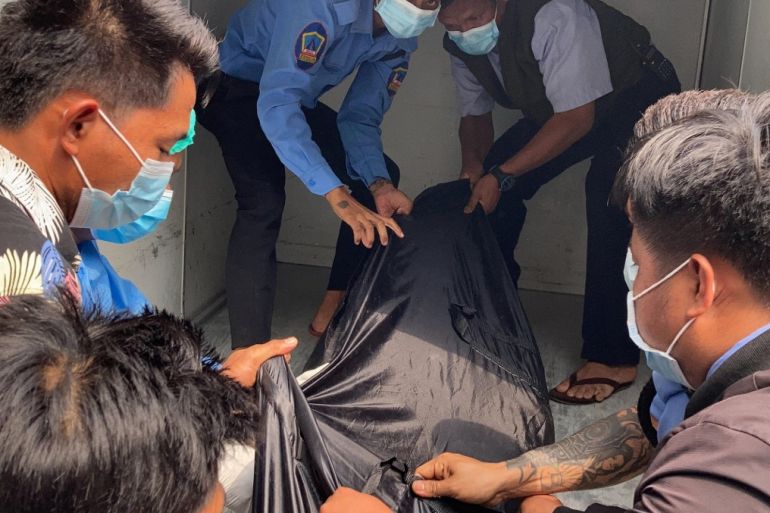Myanmar female protester dies as military crackdown hardens
First death among opponents of the February 1 military coup likely to become a rallying cry for protesters.

A young woman protester in Myanmar who was shot in the head last week as police dispersed a crowd has died, her brother said, marking the first death among opponents of the February 1 military coup since they began demonstrating two weeks ago.
News of her death on Friday came as police and soldiers arrested about 50 people in the northern town of Myitkyina, a human rights activist said, after breaking up a procession carrying banners of detained government leader Aung San Suu Kyi.
Keep reading
list of 3 itemsFor foreign investors in Myanmar, coup adds new uncertainties
UK and Canada impose sanctions on Myanmar generals after coup
Mya Thwate Thwate Khaing, who had just turned 20, had been on life support since being taken to hospital on February 9, after she was hit by what doctors said was a live bullet at a protest in the capital, Naypyidaw.
“I feel really sad and have nothing to say,” said her brother, Ye Htut Aung, speaking to the Reuters news agency by telephone.
Her death could become a rallying cry for the protesters who were again on the streets on Friday.
“I’m proud of her and I’ll come out until we achieve our goal for her,” protester Nay Lin Htet, 24, told Reuters at a rally in the main city of Yangon.
Ma Thwe Thwe Khaing, who was shot in the head by police during a violent crackdown on protesters in Naypyidaw on February 9, died at around 11 am today. She was only 19 years old. Rest in Power. #WhatsHappeningInMyanmar pic.twitter.com/UKA6FU7J98
— Linn Let Arkar (@ArkarLet) February 19, 2021
The news comes as Myanmar’s military coup leaders stepped up its crackdown against protesters that have emerged in smaller towns and cities across the country, indicating a hardened approach against dissent despite growing international pressure and expanded sanctions.
In the northern city of Myitkyina, images on social media showed on Friday the military rounding up protesters and blocking the streets in the northern city near the border with China. Several people in civilian clothes were seen being hauled up a military truck as uniformed personnel march nearby.
One video shared by the Myanmar Civil Disobedience Movement showed government forces breaking up a march and chasing away protesters at a crowded street. One officer was later shown trying to destroy the banner bearing an image of Aung San Suu Kyi.
Another video posted by US-based news website The 74 Media showed several people, among them journalists carrying their cameras, running away as they were being pursued by government forces.
Protestors in MyitKyiNa were hit and arrested by the brutal polices this morning. #WhatsHappeningInMyanmar #Feb19Coup pic.twitter.com/Tpit9dj774
— Myanmar Civil Disobedience Movement (@MyanmarCivilDob) February 19, 2021
According to reports, among those who joined in the civil disobedience protest in Myitkyina were school teachers, healthcare workers and students.
In Monywa in the Sagaing region, hundreds of protesters also took to the streets, carrying signs which read “Reject the military” as they blocked a street.
In the southern city of Kawthoung, near the border with Thailand, hundreds of Ministry of Education staff blocked a street. Some carried signs saying, “STOP Arresting People Illegally at Midnight. SAVE MYANMAR”.
Due to restrictions, Al Jazeera could not independently verify the reports.
Yangon streets blockaded
In the country’s second-largest city of Mandalay, several police officers were seen joining an anti-government march. According to reports, more than 100 officers from the city have already joined in the civil disobedience movement despite threats of losing their jobs.
In Yangon, the country’s largest city and former capital, three people were reportedly injured during a confrontation with unknown assailants, who are believed to be the same group of people attacking anti-coup marchers earlier on Friday.
In another part of downtown Yangon, security forces were seen blocking a main intersection near commercial buildings, as crowds start to gather in front of the steel barricades set up by the government.
Protesters also gathered in front of several embassies, including at the Chinese Embassy, where hundreds of demonstrators carried signs pleading for Beijing to support the country, and not the military.
8 police officers have joined in Mandalay to protest Military Coup right now. #Feb19Coup #Mandalay #WhatsHappeningInMyanmar pic.twitter.com/wWycELwnvO
— Nay Thu Rein Oo (@NayThuReinOo10) February 19, 2021
A smaller crowd gathered in front of the British Embassy, where a group of musicians played protest hymns as they pleaded for the United Kingdom to take further action against the coup leaders.
At the same time, protesters welcomed new sanctions from the UK and Canada aimed at military officials.
Youth leader and activist Thinzar Shunlei Yi applauded the UK’s asset freezes and travel bans on three generals as well as steps to stop any aid helping the military and to prevent British businesses from working with the army. Canada said it would take action against nine military officials.
“We urge other nations to have such a coordinated and united response,” she wrote on social media.
“We will be waiting for EU sanctions announcement on [February 22],” she said, calling on people to gather at the EU office push for sanctions to include measures against military businesses.

Adding to the diplomatic pressure, Japan said it had agreed with India, the United States and Australia on the need for democracy to be restored quickly.
Myanmar’s military staged a coup on February 1 after making unverified claims of election fraud.
Five days later, tens of thousands of people started taking to the streets of cities across the country to denounce the military’s move, demanding that they release the detained political leaders and activists, as well as restore the country’s duly-elected parliament.